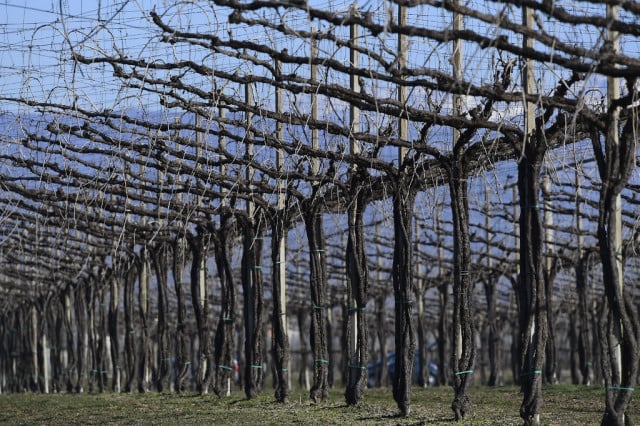Not just Prosecco: here are the other Italian sparkling wines you need to try

If you're concerned about the environmental impact of heavy prosecco production, or just want to try something new, here's our guide to Italy's other sparkling wines.
After The Local reported new research showing booming Prosecco production is eroding soil in Veneto's Conegliano Valdobbiadene vineyards, risking making production unsustainable in future, many readers were understandably horrified - especially those of you in the UK and US, Italy's biggest Prosecco export markets.
There are natural solutions to the soil erosion problem, researchers say, but whether growers of the grape used for Prosecco will adopt them is not certain.
Until then, maybe it's time we looked beyond the world-famous Prosecco DOC and tried some of Italy's less famous sparkling wines.
The good news is that, though they're not as well-known globally, Italian wine lovers insist these varieties are even better.
"When it comes to sparkling wines Prosecco is far from the only option in Italy," says wine expert Hande Leimer, a certified sommelier from the Vino Roma wine studio.
"Most wine drinkers assume 'if it's Italian and bubbly, then it must be Prosecco'. I can't blame them, as Prosecco is the number one sparkling wine of Italy in production and export numbers - followed by Asti," she says.
Hande shared a list of some of her favourite Itaiian appellations which she says "have consistently the best quality (theoretically and practically) and are easiest to find."
She points out: "Just as you shouldn’t call any sparkling wine Champagne, all these names mean a specific area and very often a specific method - and are protected by law."
Asti DOCG
A sparkling and sweet wine made from 100% Moscato Bianco grapes from the Piedmont region in the north-west of Italy. It has a rather low alcohol content (7%-9,5%) and is sweet (at least 50g/l of sugar).
The bubbles come from the fermentation process in autoclaves (pressurized tanks), which is the first and only fermentation this wine goes through and the sugar is the left over (unfermented) sugar from the grapes.
Drink it at the end of a meal, especially with pastries or creamy and fruity desserts.

Prosecco vineyards in Veneto. Photo: AFP
Lambrusco DOCs
There are five of these, from five different areas in the Emilia Romagna and Lombardy regions.
They are usually red, sparkling and dry (non-sweet).
You can find rosé or even white versions, still versions and sweet in varying degrees, too. But traditionally this is a red sparkling wine, aromatic (berries!) but not sweet, produced by using the Charmat method (after making a still wine, a second fermentation takes place in the autoclaves).
It has at least 10.5 percent alcohol content.
“If you're from the United States and have always avoided it because you don’t like sweet wine, do ask at your wine store for a dry version, which is a great aperitif wine, best paired with the fatty salumi and prosciutto of the region where it comes from,” Hande says.
Prosecco DOCGs
There are two, the wonderfully fruity Colli Asolani or Asolo, that Hande says “undeservedly often get ignored next to the bigger Conegliano Valdobbiadene - also a less strictly ruled DOC.”
“These are the wines you think you know best - but you might be surprised;” she says.
Produced 100% from Glera grapes in the cool climate and sea-fossil soils of the Veneto area, they have at least 11 percent alcohol and varying degrees of sweetness.
The most common sweetness level (always declared on the label) is extra dry, meaning there is about 15g of sugar per liter in it. Not a dessert wine, but definitely noticeably sweet.

Photo: Depositphotos
Perfect for pairing with the strong, sweet-ish taste of shrimps, especially in a risotto. Note that there are also pas dosè (zero sugar) versions of Prosecco.
The bubbles are most often produced by the Charmat method (see Lambrusco above); but there are colfòndo/metodo rurale (ever heard of decanting a sparkling wine? This is the candidate for that!) and metodo classico (see below) versions, too, which affect not only the look but also the perlage of a Prosecco. Not to forget there's a completely still version, a Prosecco spento.
Franciacorta DOCG
“This could just about be my favourite sparkling wine of Italy,” Hande says.
"It always uses the metodo classico, which is the same method that champagne uses - a second fermentation in the bottle."
Franciacorta by law has a longer minimum time for this than champagne; 24 months as opposed to 18, and comes from the shores of the Iseo Lake in the southern part of Lombardy, she explains. The grapes allowed are Pinot Nero, Pinot Bianco and Chardonnay,
"Sweetness degrees vary, though the majority is brut (below 12 grams of sugar/liter). Perlage is very fine and persistent, usually not as explosive as a Champagne and not as yeasty tasting, either.
"If you prefer an even softer style, look for the satén typology, which has less atmospheric pressure and is 100% Chardonnay.
"Hint: Franciacorta is not only for a celebratory glass of bubbles - it will pair well with many foods (except maybe a grilled steak). We drink our house Franciacorta even with pizza!"
Trento DOC
"Another appellation that always uses metodo classico. The grapes are similar to Franciacorta, with the addition of Pinot Meunier," Hande says,
"It is usually yeastier and fuller tasting than Franciacorta, which makes it a better pairing with the heavier mountain region dishes it shares its origins with. The minimum time for the second fermentation is a minimum of 15 months for the base version, though vintage and riserva versions go up to 24 and 36 respectively."
Metodo ancestrale
These sparkling wines come from almost all regions of Italy but especially from Emilia, and Hande says they're having a "glorious renaissance".
“These tend to have slight fizziness, strong aromatics and yeastiness and are pleasant on the palate and I have converted many a beer-loving man to sparkling wines with them,” she says.
There are many other sparkling wines produced in Italy, in almost every region, using one or the other of the above mentioned methods. This is just an introduction. To find out more, ask your sommelier or salesperson about the wines you'd like to try.
Comments (1)
See Also
After The Local reported new research showing booming Prosecco production is eroding soil in Veneto's Conegliano Valdobbiadene vineyards, risking making production unsustainable in future, many readers were understandably horrified - especially those of you in the UK and US, Italy's biggest Prosecco export markets.
There are natural solutions to the soil erosion problem, researchers say, but whether growers of the grape used for Prosecco will adopt them is not certain.
Until then, maybe it's time we looked beyond the world-famous Prosecco DOC and tried some of Italy's less famous sparkling wines.
The good news is that, though they're not as well-known globally, Italian wine lovers insist these varieties are even better.
"When it comes to sparkling wines Prosecco is far from the only option in Italy," says wine expert Hande Leimer, a certified sommelier from the Vino Roma wine studio.
"Most wine drinkers assume 'if it's Italian and bubbly, then it must be Prosecco'. I can't blame them, as Prosecco is the number one sparkling wine of Italy in production and export numbers - followed by Asti," she says.
Hande shared a list of some of her favourite Itaiian appellations which she says "have consistently the best quality (theoretically and practically) and are easiest to find."
She points out: "Just as you shouldn’t call any sparkling wine Champagne, all these names mean a specific area and very often a specific method - and are protected by law."
Asti DOCG
A sparkling and sweet wine made from 100% Moscato Bianco grapes from the Piedmont region in the north-west of Italy. It has a rather low alcohol content (7%-9,5%) and is sweet (at least 50g/l of sugar).
The bubbles come from the fermentation process in autoclaves (pressurized tanks), which is the first and only fermentation this wine goes through and the sugar is the left over (unfermented) sugar from the grapes.
Drink it at the end of a meal, especially with pastries or creamy and fruity desserts.

Prosecco vineyards in Veneto. Photo: AFP
Lambrusco DOCs
There are five of these, from five different areas in the Emilia Romagna and Lombardy regions.
They are usually red, sparkling and dry (non-sweet).
You can find rosé or even white versions, still versions and sweet in varying degrees, too. But traditionally this is a red sparkling wine, aromatic (berries!) but not sweet, produced by using the Charmat method (after making a still wine, a second fermentation takes place in the autoclaves).
It has at least 10.5 percent alcohol content.
“If you're from the United States and have always avoided it because you don’t like sweet wine, do ask at your wine store for a dry version, which is a great aperitif wine, best paired with the fatty salumi and prosciutto of the region where it comes from,” Hande says.
Prosecco DOCGs
There are two, the wonderfully fruity Colli Asolani or Asolo, that Hande says “undeservedly often get ignored next to the bigger Conegliano Valdobbiadene - also a less strictly ruled DOC.”
“These are the wines you think you know best - but you might be surprised;” she says.
Produced 100% from Glera grapes in the cool climate and sea-fossil soils of the Veneto area, they have at least 11 percent alcohol and varying degrees of sweetness.
The most common sweetness level (always declared on the label) is extra dry, meaning there is about 15g of sugar per liter in it. Not a dessert wine, but definitely noticeably sweet.

Photo: Depositphotos
Perfect for pairing with the strong, sweet-ish taste of shrimps, especially in a risotto. Note that there are also pas dosè (zero sugar) versions of Prosecco.
The bubbles are most often produced by the Charmat method (see Lambrusco above); but there are colfòndo/metodo rurale (ever heard of decanting a sparkling wine? This is the candidate for that!) and metodo classico (see below) versions, too, which affect not only the look but also the perlage of a Prosecco. Not to forget there's a completely still version, a Prosecco spento.
Franciacorta DOCG
“This could just about be my favourite sparkling wine of Italy,” Hande says.
"It always uses the metodo classico, which is the same method that champagne uses - a second fermentation in the bottle."
Franciacorta by law has a longer minimum time for this than champagne; 24 months as opposed to 18, and comes from the shores of the Iseo Lake in the southern part of Lombardy, she explains. The grapes allowed are Pinot Nero, Pinot Bianco and Chardonnay,
"Sweetness degrees vary, though the majority is brut (below 12 grams of sugar/liter). Perlage is very fine and persistent, usually not as explosive as a Champagne and not as yeasty tasting, either.
"If you prefer an even softer style, look for the satén typology, which has less atmospheric pressure and is 100% Chardonnay.
"Hint: Franciacorta is not only for a celebratory glass of bubbles - it will pair well with many foods (except maybe a grilled steak). We drink our house Franciacorta even with pizza!"
Trento DOC
"Another appellation that always uses metodo classico. The grapes are similar to Franciacorta, with the addition of Pinot Meunier," Hande says,
"It is usually yeastier and fuller tasting than Franciacorta, which makes it a better pairing with the heavier mountain region dishes it shares its origins with. The minimum time for the second fermentation is a minimum of 15 months for the base version, though vintage and riserva versions go up to 24 and 36 respectively."
Metodo ancestrale
These sparkling wines come from almost all regions of Italy but especially from Emilia, and Hande says they're having a "glorious renaissance".
“These tend to have slight fizziness, strong aromatics and yeastiness and are pleasant on the palate and I have converted many a beer-loving man to sparkling wines with them,” she says.
There are many other sparkling wines produced in Italy, in almost every region, using one or the other of the above mentioned methods. This is just an introduction. To find out more, ask your sommelier or salesperson about the wines you'd like to try.
Join the conversation in our comments section below. Share your own views and experience and if you have a question or suggestion for our journalists then email us at [email protected].
Please keep comments civil, constructive and on topic – and make sure to read our terms of use before getting involved.
Please log in here to leave a comment.